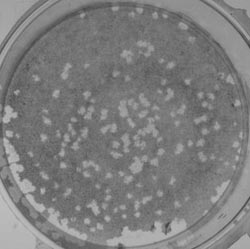Scientists find new genetic path to deadly diarrheal disease

Bright spots among intestinal cells show where the shigella bacteria were able to replicate, indicating their ability to cause disease. Credit: Erin Murphy/Ohio University<br>
The research, which could lead to the development of future treatments, was published today in the journal PLoS ONE. The study was led by Ohio University scientist Erin Murphy and doctoral student William Broach, with contributions from University of Nevada, Las Vegas and University of Texas at Austin researchers.
When the disease-causing bacterium Shigella invades a human host, environmental conditions there, such as changes in temperature or pH, stimulate a genetic expression pathway within the bacterium that allows it to survive and cause disease. Central to this genetic pathway are two proteins, VirF and VirB. VirF functions to increase production of VirB which, in turn, promotes the production of factors that increases the bacterium's virulence, or ability to cause illness in its host.
“It's like a domino effect,” said Murphy, assistant professor of bacteriology in the Ohio University Heritage College of Osteopathic Medicine.
Murphy and Broach's new study, however, suggests that production of VirB can be controlled independently of VirF. It also shows that the VirF-independent regulation is mediated by a specific small RNA, a special type of molecule whose job is to control the production of particular targets. This is the first study to demonstrate that transcription of virB is regulated by any factor other than VirF, Murphy explained.
The research not only reveals the intricate level of gene expression the bacteria employ to survive in the human body, but potentially could lead to new treatments. Currently, antibiotics are prescribed to patients with the disease.
“These findings are feeding into the basic understanding of this gene expression so that future researchers can work to disrupt it,” Broach said. “The more we know about it, the more targets we have to disrupt it and to possibly develop targeted antibiotic treatments.”
For those living in developing countries, where access to clean drinking water can be scarce, an improved medical treatment for shigellosis could mean the difference between life and death.
“In the United States, if we get severe diarrhea we can go to the store and get Gatorade,” Murphy said. “But if you're already starving to begin with because you don't have access to good food and clean water, then you get shigellosis on top of that—and you don't have good water to rehydrate yourself—that's when the deaths happen.”
The disease, which is transmitted person to person or through contaminated food or water sources, has an infectious dose of just 10 organisms, meaning as few as 10 organisms can cause disease in a healthy person. This infectious dose is exceedingly low compared to other bacteria that require tens of thousands of organisms to cause disease.
While it is often thought to be a third-world problem, shigellosis causes a reported 14,000 cases in the United States each year. The Centers for Disease Control suggests that the actual number may be 20 times higher, as mild cases often aren't reported or diagnosed.
“In the United States it's probably even more underreported than in developing countries because of access to healthy, clean drinking water,” Murphy said. “If you're a healthy individual and you've got access to clean drinking water, chances are you're going to get severe diarrhea, but you're not going to die.”
The research was funded by the National Institutes of Health, the Ohio University Research Committee and the Ohio University Heritage College of Osteopathic Medicine.
The collaborators on the PLoS ONE paper are University of Nevada, Las Vegas scientists Nicholas Egan and Helen Wing and University of Texas at Austin researcher Shelley Payne.
The PLoS ONE paper can be accessed online: http://dx.plos.org/10.1371/journal.pone.0038592
Media Contact
More Information:
http://www.ohio.eduAll latest news from the category: Life Sciences and Chemistry
Articles and reports from the Life Sciences and chemistry area deal with applied and basic research into modern biology, chemistry and human medicine.
Valuable information can be found on a range of life sciences fields including bacteriology, biochemistry, bionics, bioinformatics, biophysics, biotechnology, genetics, geobotany, human biology, marine biology, microbiology, molecular biology, cellular biology, zoology, bioinorganic chemistry, microchemistry and environmental chemistry.
Newest articles

How 3D printers can give robots a soft touch
Soft skin coverings and touch sensors have emerged as a promising feature for robots that are both safer and more intuitive for human interaction, but they are expensive and difficult…

Oxygen vacancies mediated ultrathin Bi4O5Br2 nanosheets
… as efficient piezocatalyst for synthesis of H2O2 from pure water. As an important chemical raw material, hydrogen peroxide (H2O2) is widely applied in various aspects of industry and life….

Atom-by-atom: Imaging structural transformations in 2D materials
Silicon-based electronics are approaching their physical limitations and new materials are needed to keep up with current technological demands. Two-dimensional (2D) materials have a rich array of properties, including superconductivity…





















